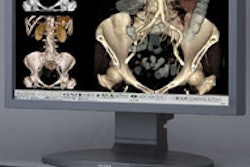Many options are available for converting emergency departments, operating rooms, and intensive care units to a filmless environment. But a flexible approach that accounts for clinicians' needs and preferences can ease the conversion process, according to Dr. David Weiss of the Geisinger Medical Center in Danville, PA.
"Our job is to help clinicians evaluate their needs, and then to provide what they need," Weiss said in a presentation at PACS 2005: The Expanding Integrated Digital Healthcare Enterprise, a March conference in San Antonio sponsored by the University of Rochester School of Medicine & Dentistry in Rochester, NY.
In critical care areas such as ICUs, PACS hardware requirements depend on the type of PACS being used, such as an enterprise PACS or a separate Web-based server and software. As for software requirements, don't neglect worklist functionality, with filtering capability by location, attending physician, and resource, Weiss said.
Online conferencing capability is also helpful, he added. In the OR, clinicians need to be able to review key images.
"It's really unfair to ask a neurosurgeon to scroll through a 1,000-slice dataset every time they want to find the appropriate image during surgery," Weiss explained.
Access to reconstructed images needs to be provided, and it's important to understand that software functionality needs differ by specialty, he said.
Converting critical care units to a filmless environment confers several advantages, including instant access to images, film and personnel cost-savings, improved patient care, and improved clinician and radiologist efficiency, Weiss said.
On the other hand, there are some disadvantages, including the high initial cost, and the difficulty of implementing a new paradigm for clinicians. Some may still demand film, he said.
"We have had physicians who are still demanding film no matter what we do," Weiss said. "And it doesn't seem to vary by specialty. There are physicians in each specialty that just simply like film."
Also, the responsibility for displaying cases in the OR must be determined, and a filmless environment requires technical support resources outside of radiology, he said.
ED
In the emergency room, the number of monitors (one or two) must be chosen, a decision that depends on clinician preference as well as volume and efficiency demands, Weiss said. The software and monitor resolution should be the same as diagnostic radiology.
Even more important considerations in the ED include lighting, space, and acoustics. At Geisinger, patient rooms have wall-mounted monitors; tablet PCs could also be considered for this application, he said.
In the trauma bay, considerations include the location of the PACS workstation and monitor, monitoring devices, imaging modalities (such as ultrasound, CT, and computed radiography), workspace and workflow, and personnel restrictions, Weiss said.
Critical care units have similar workflow as nontrauma EDs, and require the same software as diagnostic radiology, Weiss said. Monitor resolution should be of diagnostic quality, with care given to appropriate space, lighting, and acoustics.
OR
The OR offers a number of options for a filmless environment. For example, institutions might settle on a cart with a PACS workstation, a wall-mounted monitor, a ceiling-mounted articulating arm monitor, or a wall-mounted large flat-panel display, Weiss said.
A cart with a PACS workstation is a less-expensive option, especially with a thick-client setup, he said. A wireless connection is desirable. With a cart, access across multiple rooms can be an issue, however, and floor space and clutter should be considered, he said.
A wall-mounted monitor is often the least expensive option, and is a good choice when diagnostic quality is unnecessary, Weiss said.
In the OR, monitor navigation and control are issues. Often, a circulating nurse can handle this task, but sometimes a surgeon or a scrub nurse will be in control, he said. In the latter case, a mouse and keyboard in sterile wrap will be necessary. A gyroscopic mouse in a sterile wrap has also proved successful for some institutions, he said. Vendors are also experimenting with voice- and gesture-controlled solutions.
Geisinger decided to let its surgeons decide what approach they wanted, either creating a committee or using an existing OR committee for the process. Options were presented to the committees via mock-ups.
The institution planned for flexibility and to be accommodating to different requests, Weiss said. In fact, the main hospital chose to deploy a large plasma monitor, while a smaller Geisinger hospital selected a ceiling-mounted arm with a monitor.
Some issues that arose during deployment included determining responsibility for bringing up images, and nonmedical uses interfering with function, he said. Technical support outside of the radiology department also proved challenging; surgeons don't want to wait for their images.
"If there was any issue whatsoever, they said, 'I don't want your support. I just want your films. Print me films and bring them up here right away,'" Weiss said. Problems often resulted from password and login issues, he said.
As for financial concerns, costs will vary with PACS and monitor type. It's a good idea, then, to individualize PACS budgets by department, Weiss said.
By Erik L. Ridley
AuntMinnie.com staff writer
June 7, 2005
Related Reading
PDAs show promise for RIS/PACS portability, May 13, 2005
3D: Rendering a new era, May 2, 2005
Many skills needed for cardiology PACS administrator role, April 25, 2005
Planning mitigates PACS data migration, March 21, 2005
PACS improves care, builds interhospital relationships, March 14, 2005
Copyright © 2005 AuntMinnie.com




















